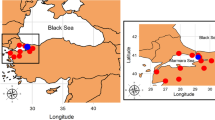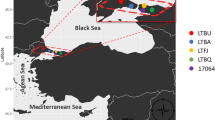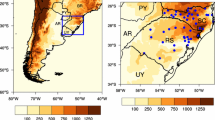Abstract
The short waves (less than 6000 km) embedded within the long waves and the resulting short-wave troughs have an effect on the sea-effect snow (SES). The short-wave troughs, which accompany most of the SES events, directly affect the formation and intensity of the bands, especially along their trajectories. In this study, the structure and characteristics of short-wave troughs and long waves during the occurrence of SES bands over the western Black Sea during nine winter periods (2010–2018) were investigated. A total of 48 short-wave troughs and long waves that concurred with snow events were detected in the period. In the classification made according to the movement direction followed by the short-wave troughs, it was determined that the western movement was dominant. This was mostly observed due to the latitudinal movements of the long waves. The average duration of the short-wave troughs over the region was found to be 27.8 h, while the longest duration trough lasted 60 h (LWT-Type). The most obvious effects of long waves were in the form of handling short waves. Apart from these, it also played a critical role in lowering arctic and polar air longitudinally to the south. The short-wave troughs allowed the convection to increase and contributed to the formation of severe SES bands by playing a role in the deepening of the convective boundary layer. The SES bands mostly had more than one parallel band formation in longitudinal direction. Movement directions of short-wave troughs and long waves mostly concurred with the SES bands (77–79%). Therefore, it is possible to talk about the effects of short and long waves not only in the change of boundary layer properties, but also in the direction of the upper atmospheric level (sub-inversion wind directions) movements.









Similar content being viewed by others
References
Aalijahan M, Salahi B, Rahimi YG, Asl MF (2019) A new approach in temporal-spatial reconstruction and synoptic analysis of cold waves in the northwest of Iran. Theor Appl Climatol 137:341–352. https://doi.org/10.1007/s00704-018-2601-7
AMS (2021) American Meteorological Society: Glossary of Meteorology. https://glossary.ametsoc.org/wiki/Long_wave. Accessed 12 October 2021
APDRC (2021) Asia-Pasific Data-Research Center: sea surface temperatures. http://apdrc.soest.hawaii.edu. Accessed 15 October 2021
Baltaci H, Gokturk OM, Kindap T, Unal A, Karaca M (2015) Atmospheric circulation types in Marmara Region (NW Turkey) and their influence on precipitation. Int J Climatol 35(8):1810–1820. https://doi.org/10.1002/joc.4122
Baltaci H, Kindap T, Unal A, Karaca M (2017) The influence of atmospheric circulation types on regional patterns of precipitation in Marmara (NW Turkey). Theor Appl Climatol 127:563–572. https://doi.org/10.1007/s00704-015-1653-1
Baltaci H, da Silva MCL, Gomes HB (2021) Climatological conditions of the Black Sea-effect snowfall events in Istanbul. Turkey Int J Climatol 41(3):2017–2028. https://doi.org/10.1002/joc.6944
Brunner L, Schaller N, Anstey J, Sillmann J, Steiner AK (2018) Dependence of present and future European temperature extremes on the location of atmospheric blocking. Geophys Res Lett 45:6311–6320. https://doi.org/10.1029/2018GL077837
Bard L, Kristovich DAR (2012) Trend reversal in Lake Michigan contribution to snowfall. J Appl Meteor Climatol 51(11):2038–2046. https://doi.org/10.1175/JAMC-D-12-064.1
Dockus DA (1985) Lake effect snow forecasting in the computer age. Natl Wea Dig 10(4):5–19
Efe B, Lupo AR, Deniz A (2019) The relationship between atmospheric blocking and precipitation changes in Turkey between 1977 and 2016. Theor Appl Climatol 138:1573–1590. https://doi.org/10.1007/s00704-019-02902-z
Efe B, Sezen İ, Lupo AR, Deniz A (2020) The relationship between atmospheric blocking and temperature anomalies in Turkey between 1977 and 2016. Int J Climatol 40(2):1022–1037. https://doi.org/10.1002/joc.6253
Efe B, Lupo AR (1898) Deniz A (2020b) Extreme temperatures linked to the atmospheric blocking events in Turkey between 1977 and 2016. Nat Hazards 104:1879. https://doi.org/10.1007/s11069-020-04252-w
Ellis AW, Leathers DJ (1996) A synoptic climatological approach to the analysis of lake-effect snowfall: potential forecasting applications. Weather Forecast 11:216–229. https://doi.org/10.1175/1520-0434(1996)011%3c0216:ASCATT%3e2.0.CO;2
Goree PA, Younkin RJ (1966) Synoptic climatology of heavy snowfall over the central and eastern United States. Mon Wea Rev 94(11):663–668. https://doi.org/10.1175/1520-0493(1966)094%3c0663:SCOHSO%3e2.3.CO;2
Hanks HH, de Harpporte DR Jr, Grueber EC (1967) Snow forecasting procedures in the central United States. Final Report, Contract, Cwb-11353, Atmospheric Research and Development Corp., Kansas City, MO, 33.
Hjelmfelt MR (1990) Numerical study of the influence of environmental conditions on lake-effect snow-storms on Lake Michigan. Mon Wea Rev 118:138–150. https://doi.org/10.1175/1520-0493(1990)118%3C0138:NSOTIO%3E2.0.CO;2
Hjelmfelt MR (1992) Orographic effects in simulated lake-effect snowstorms over Lake Michigan. Mon Wea Rev 120:373–377. https://doi.org/10.1175/1520-0493(1992)120%3c0373:OEISLE%3e2.0.CO;2
Holton JR, Hakim GJ (2013) An introduction to dynamic meteorology. Academic Press, Waltham, MA. https://doi.org/10.1016/B978-0-12-384866-6.00001-5
Jiusto JE, Kaplan ML (1972) Snowfall from lake-effect storms. Mon Wea Rev 100(1):62–66. https://doi.org/10.1175/1520-0493(1972)100%3c0062:SFLS%3e2.3.CO;2
Kindap T (2010) A severe sea-effect snow episode over the city of Istanbul. Nat Hazards 54:707–723. https://doi.org/10.1007/s11069-009-9496-7
Kocin PJ, Schumacher PN, Morales RF Jr, Uccellini LW (1995) Overview of the 12–14 March 1993 superstorm. Bull Americ Met Soc 76(2):165–182. https://doi.org/10.1175/1520-0477(1995)076%3c0165:OOTMS%3e2.0.CO;2
Kunkel KE, Wescott NE, Kristovich DAR (2002) Assessment of potential effects of climate change on heavy lake-effect snowstorms near Lake-Erie. J Gt Lakes Res 28:521–536. https://doi.org/10.1016/S0380-1330(02)70603-5
Laird NF, Metz ND, Gaudet L, Grasmick C, Higgins L, Loeser C, Zelinsky DA (2017) Climatology of cold season lake-effect cloud bands for the North American Great Lakes. Int J Climatol 37(4):2111–2121. https://doi.org/10.1002/joc.4838
Mahoney EA, Niziol TA (1997) BUFKIT: a software application tool kit for predicting lake-effect snow. Preprints, 13th Int. Conf. on Interactive Information and Processing Systems for Meteorology, Oceanography, and Hydrology, Long Beach, CA, Amer Meteor Soc 388–391.
Markowski P, Richardson Y (2010) Mesoscale Meteorology in Midlatitudes. Wiley-Blackwell, 407 pp.
Metz ND, Bruick ZS, Capute PK, Neureuter MM, Ott EW, Sessa MF (2019) An investigation of cold-season short-wave troughs in the great lakes region and their concurrence with lake-effect clouds. J Appl Meteorol Climatol 58(3):605–614. https://doi.org/10.1175/JAMC-D-18-0177.1
Niziol TA (1987) Operational forecasting of lake effect snowfall in western and central New York. Weather Forecast 2(4):310–321. https://doi.org/10.1175/1520-0434(1987)002%3C0310:OFOLES%3E2.0.CO;2
Niziol T, Snyder W, Waldstreicher J (1995) Winter weather forecasting throughout the eastern United States. Part IV: lake effect snow. Weather Forecast 10:61–77. https://doi.org/10.1175/1520-0434(1995)010%3c0061:WWFTTE%3e2.0.CO;2
Notaro M, Zarrin A, Vavrus S, Bennington V (2013) Simulation of heavy-lake effect snowstorms across the Great Lakes basin by RegCM4: synoptic climatology and variability. Mon Wea Rev 141(6):1990–2014. https://doi.org/10.1175/MWR-D-11-00369.1
NOAA (2021) National Oceanic and Atmospheric Administration: NCEP/NCAR Reanalysis II. https://psl.noaa.gov/data/gridded/data.ncep.reanalysis.pressure.html. Accessed 7 October 2021
NWS (2021) National Weather Service: Basic wave patterns. https://www.weather.gov/jetstream/basic Accessed 7 October 2021
Özdemir ET, Yetemen Ö (2019) Meteorological analysis of lake enhanced snow in Istanbul, on February 17–19, 2015. J Anatol Env Anim Sci 4(2):115–121 ((in Turkish))
Pike WS, Webb JDC (2020) The very deep cold pool, and lake-effect snowfalls of 27 February–1 March 2018. Weather 75(3):88–98. https://doi.org/10.1002/wea.3675
Rabinowitz JL, Lupo AR, Guinan PE (2018) Evaluating linkages between atmospheric blocking patterns and heavy rainfall events across the north-central Mississippi River valley for different ENSO phases. Adv Meteorol Article ID 1217830. https://www.hindawi.com/journals/amete/2018/1217830/
Reinking RF, Caiazza R, Kropfli RA, Orr BW, Martner BE, Niziol TA, Byrd GP, Penc RS, Zamora RJ, Snider JB, Ballentine RJ, Stamm AJ, Bedford CD, Joe P, Koscielny AJ (1993) The Lake-Ontario winter storms (LOWS) project. Bull Amer Meteor Soc 74(10):1828–1849
Rothrock HJ (1969) An aid in forecasting significant lake snows. Tech Memo WBTM CR-30, National Weather Service Central The Region, 16 pp.
Smith BB and Boris JP (2017) Lake snow parameter. National Weather Service Forecast Office, Gaylord, MI. https://www.weather.gov/apx/lake_snow_parameter. Accessed 15 October 2021.
Sousa PM, Trigo RM, Barriopedro D, Soares PMM, Ramos AM, Liberato MLR (2017) Responses of European precipitation distributions and regimes to different blocking locations. Clim Dyn 48(3):1141–1160. https://doi.org/10.1007/s00382-016-3132-5
Steenburgh WJ, Halvorson SF, Onton DJ (2000) Climatology of lake-effect snowstorms of the Great Salt Lake. Mon Wea Rev 128:709–727. https://doi.org/10.1175/1520-0493(2000)128%3C0709:COLESO%3E2.0.CO;2
Tuttle JD, Davis CA (2013) Modulation of the diurnal cycle of warm-season precipitation by short-wave troughs. J Atmos Sci 70:1710–1726. https://doi.org/10.1175/JAS-D-12-0181.1
University of Wyoming (2021) Upper-level atmospheric charts. http://weather.uwyo.edu/upperair/sounding.html. Accessed 9 October 2021
Wetter3 (2021) Archived data. http://www.wetter3.de. Accessed 9 October 2021
Wiggin BL (1950) Great snow of the great lakes. Weatherwise 3:123–126. https://doi.org/10.1080/00431672.1950.9927065
Yavuz V, Deniz A, Özdemir ET, Kolay O, Karan H (2021a) Classification and analysis of sea-effect snowbands for Danube Sea area in Black Sea. Int J Climatol 41(5):3139–3152. https://doi.org/10.1002/joc.7010
Yavuz V, Deniz A, Özdemir ET (2021b) Analysis of a vortex causing sea-effect snowfall in the western part of the Black Sea: a case study of events that occurred on 30–31 January 2012. Nat Hazards 108:819–846. https://doi.org/10.1007/s11069-021-04707-8
Acknowledgements
The authors would like to thank the Turkish State Meteorological Service for the data used in this study.
Funding
This work is funded by the Turkish Science Foundation (TUBITAK) with Grant Number 1059B142000051.
Author information
Authors and Affiliations
Contributions
Veli Yavuz: conceptualization, methodology, formal analysis, writing—original draft. Anthony R. Lupo: conceptualization, supervision, writing—review and editing.
Neil I. Fox: supervision, writing—review and editing.
Ali Deniz: supervision, writing—review and editing.
Corresponding author
Ethics declarations
Ethics approval
Not applicable.
Consent to participate
Not applicable.
Consent for publication
The authors confirm that the study is original and abide within the regulations for publication.
Conflict of interest
The authors declare no competing interests.
Additional information
Publisher's note
Springer Nature remains neutral with regard to jurisdictional claims in published maps and institutional affiliations.
Rights and permissions
About this article
Cite this article
Yavuz, V., Lupo, A.R., Fox, N.I. et al. The role of short-wave troughs on the formation and development of sea-effect snowbands in the western Black Sea. Theor Appl Climatol 149, 501–510 (2022). https://doi.org/10.1007/s00704-022-04071-y
Received:
Accepted:
Published:
Issue Date:
DOI: https://doi.org/10.1007/s00704-022-04071-y




